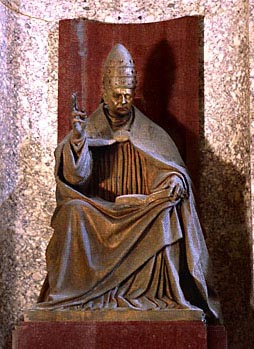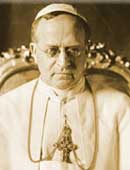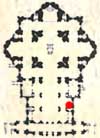
|
| Grottoes
Vatican City Colonnade Saints Floorplan #2 |
| Altars
Monuments The History |
|
Related Sites |

|
This prewar pope was the author of thirty encyclicals, the first to use radio, holder of three doctorates from the Gregorian University, and a serious advocate of mountain climbing. Pius XI took as his motto, "Christ's peace in Christ's kingdom," to make the point that the Church should be active in the world, not isolated from it.
|
 |
From: 'St. Peter's - Guide to the Basilica and Square'
In this chapel we also find two modern works. On the right is the statue
of Pius XI (1922-1939), the first sovereign of Vatican City State which
was created in 1929 as a result of the Lateran Pact. The statue was made
by Francesco Nagni (1897-1977) in 1949.
From:
'Guide to Saint Peter's Basilica'
Opposite this monument is the one to his predecessor Pope Pius XI (1922-39),
the pope of "dauntless faith", of the great social encyclicals, the pope
of Catholic Action, of the missions, of the Eucharistic Congresses, of
the University of the Sacred Heart. This pope, who could force the devastating
consequences of totalitarian regimes, condemned their doctrines from the
beginning. Pius XI was also the first Pope Sovereign of Vatican City,
a title recognized by the Lateran Treaty (11 February 1929). The monument
was created by Francesco Nagni (1949).
From: 'St. Peter's
Basilica - A Virtual Tour' by Our
Sunday Visitor
The monument to Pope Pius XI, with a superficial monumental effect, lacks
the human interpretation of the personage. In fact, the artist Pietro
Canonica concentrated exclusively on the plastic abilities, trying to
accentuate the vertical movement, crowning the figure of the Pope with
the "Triregno" which, though placed on a high base, is too heavy in the
massive mantle of the woolly chasuble, that here replaces the usual wide
cloak.
From: 'Lives of
the Popes'
Pius XI was forced to address thirty-four notes to the Nazi government
to protest its growing opposition to the Church. The break came in 1937
when he ordered his encyclical Mit brennender Sorge (Ger., "With
searing anxiety), denouncing the violations of the concordat and condemning
Nazism as fundamentally racist and anti-Christian, to be read from every
German pulpit. The letter had to be smuggled into Germany. The Nazi leadership,
caught completely off guard, was infuriated and intensified its persecution
of the Church and especially of its priests.
Other Sources
Pius XI faced a sadly disturbed postwar world, a world threatened and
tempted by fascism and communism. Far from yielding to discouragement
Pius strove mightily to rally the forces of good and to remedy the times'
evils. To remind a materialistic world of the primacy of the spiritual,
Pius established the beautiful feast of Christ the King. In thirty encyclicals
he shed light on the difficulties of the day. Outstanding were his encyclicals
on education, marriage, and above all, on the social problem.

